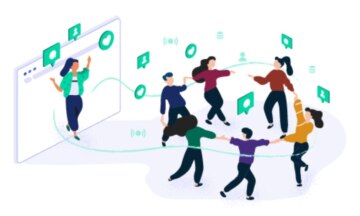Why The Best Marketers Are Adding Online Experiences to IRL Events

This post was originally published on martechseries.com
Fall in the marketing world means more than just pumpkin-spiced lattes, it’s a hectic time full of industry conferences. All you road warriors know what I’m talking about… there are too many B2B marketing events, conferences, summits, and forums to keep straight.
In the whirlwind of flights, happy hours and card-swapping, all those valuable in-person conversations can feel like they happened ages ago once you get back to the office.
So how do the best marketers leverage the valuable connection of an in-person conversation at a digital scale? Forrester analyst Laura Ramos recently examined this dilemma and found that leading B2B marketers add a virtual event component. At ON24, we’re seeing this trend heat up with many of our customers and partners making their in-person conferences available on-demand.
Here are four reasons why the industry’s best are integrating digital events with their seminar and conference strategies:
Create a better content experience for attendees

I like to think we are at the post-hardcopy phase of physical events. When you travel to a trade-show or conference today, very few booths, if any, hand out paper content. The days of lugging around tote bags full of data sheets are over. People want digital content. Unfortunately, there is no way to effectively deliver that digital content when you are in-person at an event.
In contrast, a virtual event offers more flexibility in terms of the content organizers can share with audiences. For example, during a virtual presentation, a presenter can choose to share slides, videos, white papers, case studies, and more, all alongside one another and in relation to the ongoing discussion. Viewers then have the choice to self-select a content experience that fits their needs.
The same is true with call-to-actions (CTA). Instead of telling attendees to sign up for a promotion or product when they return to the office, in a virtual space they can choose a CTA that suits their interest, whether that be further follow up or an immediate free trial. By empowering audiences to create their own experience, marketers provide their audiences with a personally tailored event at scale.
Deliver unprecedented scale and presence

When it comes to scale and reach, digital rules. With a virtual component supporting the physical event, event organizers reach audiences well beyond those who physically attended. Recorded keynote presentations can be viewed by prospects unable to attend or those who missed the opportunity. And later, that same recorded content can be viewed on-demand at leisure.
By virtualizing the event any conference, sales kick-off, or seminar becomes an instant “persistent environment” – a constant stream of on-demand digital content such as keynotes, whitepapers, videos, and more. All the content created throughout the event exists in perpetuity, outside of the actual moment of the event. No event should become irrelevant because it happened a month ago. A virtual event can preserve experiences for use well beyond the conference dates.
Change the way you qualify prospects

Virtual events can also redefine the way marketers qualify leads. Unlike in-person events, no data is lost. Organizers capture every data point an attendee creates, whether it’s an instant message or a survey question answer. Every action is logged and associated with that individual for later reference.
By capturing the minute details that happened during an event, marketers can identify and qualify leads faster and more efficiently. All of the useful context surrounding a customer’s experience is captured. What questions did they have? Which pieces of content were they most interested in? How long did they attend a session? With the right data, answers to these questions come naturally.
Later, marketers can call upon insight gathered during the event further down the funnel, selecting those prospects that are most promising, and those not to be bothered with.
Faster and more efficient sales follow up

This, I believe, is the primary reason marketers must have a digital presence coinciding with any live event today. A recent study found that 27% of marketers follow-up with event leads 7 to 13 days after the actual event – 12% wait two to four weeks! During that time valuable context and momentum are lost. In contrast, leads generated by virtual events are sales-ready from the time of capture and follow-up can occur almost immediately.
Instead of waiting for badge scans to load and classify, a virtual event provides marketers with instant integration. The data collected is instantly integrated with existing CRM systems and can be acted upon immediately after, making the handoffs event marketing teams share with sales teams richer and more insightful.
Moreover, sales teams get the exact context a customer had during the event. A sales rep can pick up the customer conversation exactly where it ended post-event. There’s nothing lost in the transfer and, for the customer, it feels natural, like the conversation just continues from one rep to another. This is extremely important – no customer enjoys repeating themselves.
Expanding your audience

The primary fear that most marketers have with adding virtual to their physical events is that the virtual will somehow cannibalize the physical. And while certainly a justified concern, the counter-argument is even more compelling. A majority of the prospects that you invite to your events will not attend, though many probably wish they could. Perhaps they don’t have a travel budget or maybe their schedules are simply too busy. Why not provide those who can’t attend with an option to participate in your event? Even if they don’t have the full conference experience, they can still take in the content they are most interested in and you still create moments to engage with them.
These virtual experiences can be large scale environments that replicate an in-person conference or simply webinars that broadcast key presentations, either live or on-demand, to extend the value of your content.
There is a time where I can see digital and live events merging seamlessly in the near future. We’re not there yet, but the capabilities available today are poised to dramatically change the event experience, surfacing more detail and actionable insight than ever before. If you’re a marketer planning your next live event, don’t forget about your digital audience! Your sales teams and CMO will thank you.